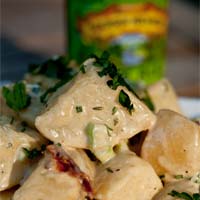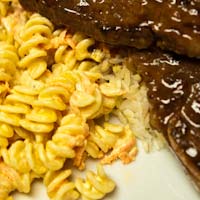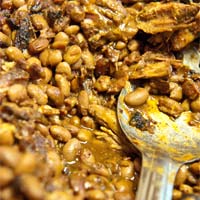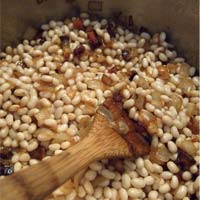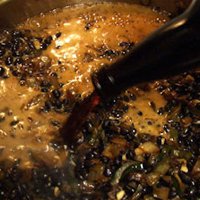Porter Beer Brined Pork Shoulder
 When you think barbecue, it’s hard not to think about smoke. Why not try a smoked, Porter-infused pork shoulder? This recipe utilizes a beer brine, flavoring the meat from the inside out, making sure to have moist and juicy BBQ pork shoulder. This Porter Beer Brined Pork Shoulder recipe is perfect for a crowd, any summer BBQ, making pork sandwiches with it, to serving it alongside some amazing BBQ Side Dishes.
When you think barbecue, it’s hard not to think about smoke. Why not try a smoked, Porter-infused pork shoulder? This recipe utilizes a beer brine, flavoring the meat from the inside out, making sure to have moist and juicy BBQ pork shoulder. This Porter Beer Brined Pork Shoulder recipe is perfect for a crowd, any summer BBQ, making pork sandwiches with it, to serving it alongside some amazing BBQ Side Dishes.
What is the difference between a Pork Butt and Pork Shoulder cut?
What’s in a name when it comes to a cut of meat is important. What you might think is one thing, is actually another. When looking at the anatomy of a pig, the “pork butt” is actually located behind the neck, not the rear of the pig. Yes, that is correct, the pork butt is not the gluteus maximus of the pig. Pork butt is sometimes called a Boston Butt, depending on where you live. And to make it more confusing, a “pork shoulder” isn’t the shoulder either, this cut is actually below the butt, above the foreleg. Why these definitions and names were labeled this way, I do not know. I just want to help you understand what you are buying and why it matters.
Both pork butt | shoulder have many things in common. Both cuts of the pig are marbled with intramuscular fat, the butt having more of it than the shoulder. This fat to meat ratio is important, as the meat cooks, the fat melts, making the meat tender and full of flavor. Yes, the saying is true, “fat = flavor”. Yet, when it comes to cooking these meat cuts, they both benefit from the low and slow method of cooking, meaning a longer cooking time and a lower cooking temperature. In other words, these pork cuts don’t make a good steak. Leave that to a pork chop or the loin section of the pig.
The pork butt is usually preferred over the shoulder, as the shape of the butt is move uniform in size and shape. The butt is more rectangular, with a more even thickness from one side to the opposite. The shoulder is more triangular, with a tapered side that will cook faster than the thicker, wider end.
Both the pork butt | shoulder are sold with or without the skin. I usually prefer a skinless cut for this beer injected smoked pork butt recipe. As the crispy skin isn’t the goal of this recipe and the BBQ rub doesn’t stick to the skin as well as the meat muscle, skinless makes more cooking sense.
To learn more about the different cuts of a pig, check out this page.
How to Make a Porter Beer Brine:
With pork, creating a Beer Brine and using it to not only flavor the protein, but to increase the moisture content of the meat. Using a roasty Porter beer, with the addition of molasses (increasing the dark lingering flavors through sweetness plus the additional minerals and vitamins that are from this sugar byproduct), Dry Malt Extract (DME) reinforcing the beer’s flavor and salt. This is the basic brine, that has salt and sugar, enough to balance out each other, yet this only adds so much flavor. To increase the flavor umbrella, I add garlic and bay leaves to the classic cooking elements of onions, carrots, and celery. These vegetables add sweetness and savory undertones, just as the French and Italians use these basic vegetables, called mirepoix and soffritto. These foundational ingredients, add depth to the beer brine, that infuse into the meat, flavoring the protein inside out, in the same way as my Beer Brined Turkey recipe does.
When cooking with beer, the beer style is important, as are the flavors the brewer is trying to capture with his | her inspiration. There are many different Porter styles that could all work in this recipe. An American Porter and English Porter will be the most entry-level brews to use, constructing a wonderful, rich, malty, and roasty base flavor profile for the rest of the ingredients to shine with. A Robust Porter and Imperial Porter are stronger alcohol versions, with a more aggressive intensity with more perceived bitterness and astringency. These brews will leave a stronger flavor in the finished pork recipe. If a Baltic Porter is used to craft the beer brine, a sweeter undertone, with a stronger malt profile will be perceived when tasting the Porter Beer Brined Pork Shoulder. Using a Smoked Porter is especially helpful in the cooking process, as the smoked malted used to make this beer style will infuse with the meat, allowing you to not use a smoker and instead of using a standard oven, set to the same temperature as a wood-fired smoker would be used.
Charcoal is great to start a fire, building a bed of good coals to keep the heat, yet charcoal doesn’t generate the needed smoke to a BBQ as wood chips or chunks contribute. When thinking about BBQ over a fire, we have to look around the world to all the types of wood one can use for heat and smoke. I do like Hickory Wood Chunks and Oak BBQ Smoking Chips
as the smoke is rich and strong. For this recipe, I prefer to add a more delicate smoke with more subtle flavors, that won’t overwhelm the Poter beer choice that was used in the beer brine, to marinade the pork meat. Other types of oak are now available, which have had a prior life, crafted into barrels, soaked full of bourbon. These Jack Daniel’s Tennessee Whiskey Barrel Smoking Chips
will add a different nuance to the final BBQ much like a barrel-aged Porter would. This is were fruit and nut woods create a unique and delicious twist to any BBQ recipe. With the addition of fruit tree wood, the smoke from apple
| cherry
| pecan
| peach
| fig wood is more well rounded. my preference to make great BBQ is to layer the smoke, using different wood chips | chunks, over the cooking time. I will divide the wood chips | chunks in different containers and submerge them in more beer and | or water, to soak and rehydrate them. This is critical, as the wet wood will smolder and create more smoke, filling the smoker, grill, or Big Green Egg with smoke. Every hour I will check the coals, adding a different soaked wood, to layer that smoke onto the beer brined pork. This culinary technique will improve your smoke ring, or the deep red hue that surrounds the meat, showing the flavor infusion into the protein. If you are using a gas grill, wrap the soaked wood in aluminum foil, creating a packet that can be placed over the flames. Preheat the grill, then turn off the center flames, leaving only a side or both sides going, adjusting the heat to keep a steady heat. Place your foil packet over those flames to create smoke and not leaving a mess to clean up later.
If you chose to use a different beer style to cook with, a different type of tree should be considered to yield a different flavored smoke that will complement the beer brine. Maple | Mesquite
| Alder
is popular woods for smoking | BBQing. A Porter | Stout | Märzen | Chili Beer | Gose | Red Ale | Amber | Rye beer could benefit from the right choice of wood, using to smoke a beer brined pork butt | shoulder.
Once finished beer brining the pork, do not save and re-use the brine. It will have done its job, infusing its flavor into the meat and will not be as good, nor yield the same results for the second brining.
If you don’t have as much time to Beer Brine this pork, follow my directions and steps to create a Blind Pig-Injected Smoked Pork Butt, instead substituting a Porter beer for the Russian River Brewing Co. Blind Pig IPA.
Many recipes for BBQ Pork and Brisket, often rub the protein with a Spice Rub. If you are a lover of a thicker bark, then add a Spice Rub, such as my Home Brew Chef All Purpose BBQ Rub, rubbing it in, all over the meat before placing it into the smoker.
Makes: 1-gallon beer brine, good for a 6-pound pork shoulder | butt, feeding 8–10 people
Porter Beer Brined Pork Shoulder Special Equipment:
Equipment: Smoker | BBQ Grill | Big Green Egg
Temperature Control: Probe style Thermometer
Charcoal: LAZZARI Mesquite Charcoal to start the fire if using a wood fire-heated smoker
Firewood: such as oak, almond or a fruitwood like cherry or apple
Wood Chips: a mix, such as Alder | Apple | Cherry
| Peach
| Pecan
| Maple
| Mesquite
Adapted from BeerAdvocate Magazine: Cuisine à la Bière | May 2008 | Issue #16

| Servings | Prep Time |
| 10 guest | 15 minute |
| Cook Time | Passive Time |
| 10 hour | 72 hour |
|
|

|
Using the roasty flavors of an American style Porter into a beer brine, infuses these flavors into a pork shoulder | butt. This Porter Beer Brined Pork Shoulder recipe is perfect for the grill | smoker.
|
- 3 cup water
- 1 cup salt, kosher
- 1/2 cup Dry Malt Extract (DME) available at Beer Beer and More Beer
- 1/4 cup molasses, black strap,
- 2 tablespoon peppercorns, black, organic, whole
- 8 each garlic, cloves peeled and minced
- 5 each bay leaves, preferably fresh torn
- 3 each carrots, large peeled and chopped
- 2 each celery, stalks, washed and chopped
- 1 each onion, yellow, large, peeled and chopped
- 2 quart ice
- 5 cup Porter, cold, such as Founders Brewing Co. Porter or other American Porter
- 6 pound pork shoulder | pork butt, bone in
-
1 teaspoon
liquid smoke optional (for Conventional Oven Cooking), such as Stubb's Mesquite Liquid Smoke - 5 oz
or Wright's Hickory Seasoning, Liquid Smoke, 3.5 oz
- In a large pot over medium heat, add the water, salt, DME, molasses, peppercorns, garlic, bay leaves, carrots, celery and onion. Stir occasionally until the mixture comes to a boil and then simmer for 10 minutes. Turn off the heat and let the mixture sit for 15 minutes to infuse the flavors. Add ice and cold porter beer to chill the brine to approximately 40°F | 4°C.
- Transfer the cooled brine to a large container that will hold both the brine and the displacement of liquid from the pork (about 2 gallons of volume will be needed). Add the pork, placing a plate or some other heavy waterproof item atop the shoulder, weighing it down so that it is completely submerged in the brine and refrigerate for 48 – 72 hours. The general rule of thumb is to brine 12 hours per 1 pound of pork. Each day, rotate the pork to re-distribute the brine over the meat.
- Remove the pork from the brine at least 12 – 24 hours before cooking, still keeping it cool in the refrigerator. This will help the meat form a pellicle, which helps the smoke stick to its surface. Remove the pork shoulder from the refrigerator once you start prepping the coals.
- If you have a wood fire smoker, start with 2 pounds of charcoal in the coal box. In separate medium-sized bowls, add 3/4 pound of each type of wood chip, adding enough water to cover the chips. Let them soak for 30 – 45 minutes. Once the coals start to show a light layer of white ash on the outside, place a medium-size log of firewood onto the coals and seal the hot box. Place a water pan under the grill rack and the pork on top. This will help keep a moist environment for the pork. Adjust your air intake and the number of coals to keep the temperature between 250°F | 121°C and 275°F | 135°C. Check the coals, adding more firewood periodically, usually every 45 minutes. The pork will cook for 8 to 10 hours at this low temperature. The ideal internal temperature for the pork is 205°F | 96°C when the bone can easily be removed from the meat without any effort.
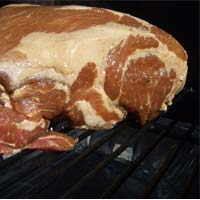
- After 6 hours of smoking, it is time to start layering the smoke flavors. Start by adding the applewood soaked chips | chunks, a small handful at a time, every 20 minutes for an hour. Next, add the cherry wood chips in the same fashion as the applewood. Finally, add the pecan wood chips following the same procedure. The cooking time should be about 9 hours at this point. Thereafter, any remaining wood chips can be mixed together and added every 20 minutes as before. This technique adds extra layers of smoke, creating a “smoke ring,” just under the skin, a true sign of good barbecue. The pork should be dark, almost black in color, and should nearly fall apart at the touch of a fork or knife. Remove the pork from the smoker and transfer it to a platter, letting it sit wrapped in foil for 20 – 30 minutes to redistribute the juices, before cutting or serving.

- Each time the door of the smoker and coal box is opened, heat is lost, taking extra time to bring the smoke chamber back to temperature, to cook the meat. Try not to open the door unless necessary, keeping the heat and smoke in the smoker. Follow these instructions and barbecue techniques to achieve mouthwatering, lip-smackin’ barbecue.
- In case you don’t have a smoker, preheat the oven to 250°F | 121°C. Rub 1 teaspoon of liquid smoke into the pork shoulder. Place the pork in the center of a roasting pan on a rack. Place the pan in the center of the oven and cook for 8 hours. The pork should be so tender it almost melts to the touch with an internal temperature of 205°F | 96°C. Remove the meat from the oven and let it rest for 20 – 30 minutes, tented in aluminum foil.
- Once the meat has cooked, rested, curiosity and hunger have outweighed the idea of waiting any longer, pull the pork apart into thin strips. Serve in a large bowl. The pork may be served as is, or mixed with the Red Ale Barbecue Sauce or IPA Mustard Sauce recipe. Some prefer to chop the meat into small chunks, others slice the meat like a roast or you could just let the guests “dig in.” Whatever approach is taken, do not trim the smoky crust, aka BARK, that holds most of the smoke flavor. Mixing it into the pulled meat brings the flavor of barbecue to the dish. If the meat seems dry, try adding 4 - 8 ounces of Porter into it.
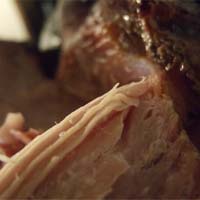
Recipes to Serve with this Recipe:

More BBQ Recipes:
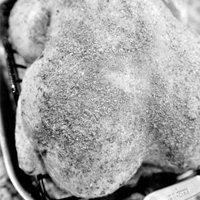
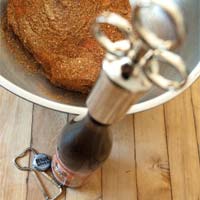


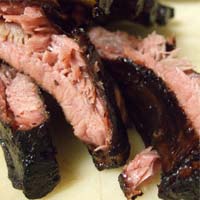


Beer BBQ Sauce Recipes:



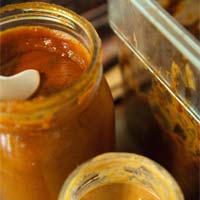

Side Dishes Cooked with Beer:


